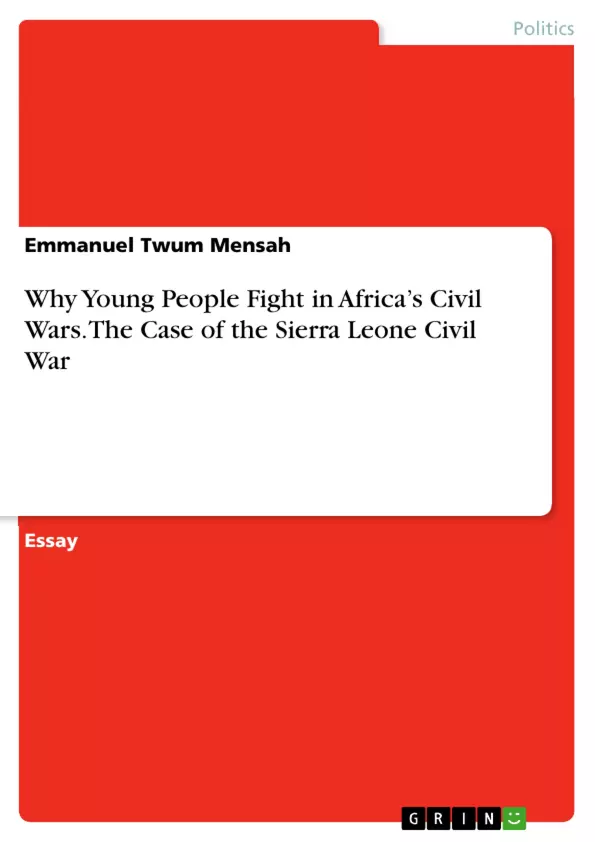This essay focuses on both local and individual context to combine the arguments on the patrimonial state crisis leading to socio-economic marginalisation of young people, and Vigh’s (2006) concept of social navigation to understand why young people fight in Africa’s civil wars. Using the Sierra Leone civil war as a case study, this essay argues that the pre-war socio-economic crisis suffered by young people as a result of the failures of the patrimonial state to honour its promises to young people remains a significant factor in influencing young people’s decision to fight in civil wars. The essay further argues that once a civil war begins, other young people are drawn to fight because of their quest to navigate the murky environment of war as active agents bent on improving their life chances for survival by taking advantage of the economic and social opportunities that come with wielding a gun as a combatant.
Inhaltsverzeichnis (Table of Contents)
- Introduction:
- Understanding the Sierra Leone Civil War
- Young People As Combatants in The Sierra Leone Civil War.
- Conclusion..
Zielsetzung und Themenschwerpunkte (Objectives and Key Themes)
This essay investigates the reasons why young people participate in civil wars in Africa, specifically focusing on the Sierra Leone Civil War. It aims to combine arguments on the patrimonial state crisis and its impact on young people's socio-economic marginalization with the concept of social navigation to explain their motivations for fighting.
- The role of the patrimonial state in creating socio-economic marginalization among young people in Africa.
- The impact of civil war on young people's life chances and their motivations for joining rebel groups.
- The concept of social navigation and how young people navigate the complexities of war to improve their survival prospects.
- The Sierra Leone Civil War as a case study to examine the motivations and experiences of young combatants.
- The role of various actors, including the RUF, the government, and international forces in shaping the conflict and the experiences of young people.
Zusammenfassung der Kapitel (Chapter Summaries)
- Introduction: This chapter provides an overview of civil conflicts in Africa during the post-Cold War era and highlights the prominence of young people as combatants. It discusses various explanations for their involvement, including the "new barbarism" and "youth bulge" theses.
- Understanding the Sierra Leone Civil War: This chapter provides a background to the Sierra Leone Civil War, outlining the origins of the conflict, the key actors involved, and the role of the RUF in mobilizing young people.
- Young People As Combatants in The Sierra Leone Civil War: This chapter delves into the motivations of young people for joining the fighting forces, both rebel and government. It explores the factors that pushed them towards conflict, such as poverty, lack of opportunities, and the desire to improve their life chances.
Schlüsselwörter (Keywords)
Key themes explored in this essay include: civil war, Africa, Sierra Leone, young people, combatants, patrimonial state, socio-economic marginalization, social navigation, life chances, conflict motivation, and the Revolutionary United Front (RUF).
- Quote paper
- Emmanuel Twum Mensah (Author), 2021, Why Young People Fight in Africa’s Civil Wars. The Case of the Sierra Leone Civil War, Munich, GRIN Verlag, https://www.grin.com/document/1066328



